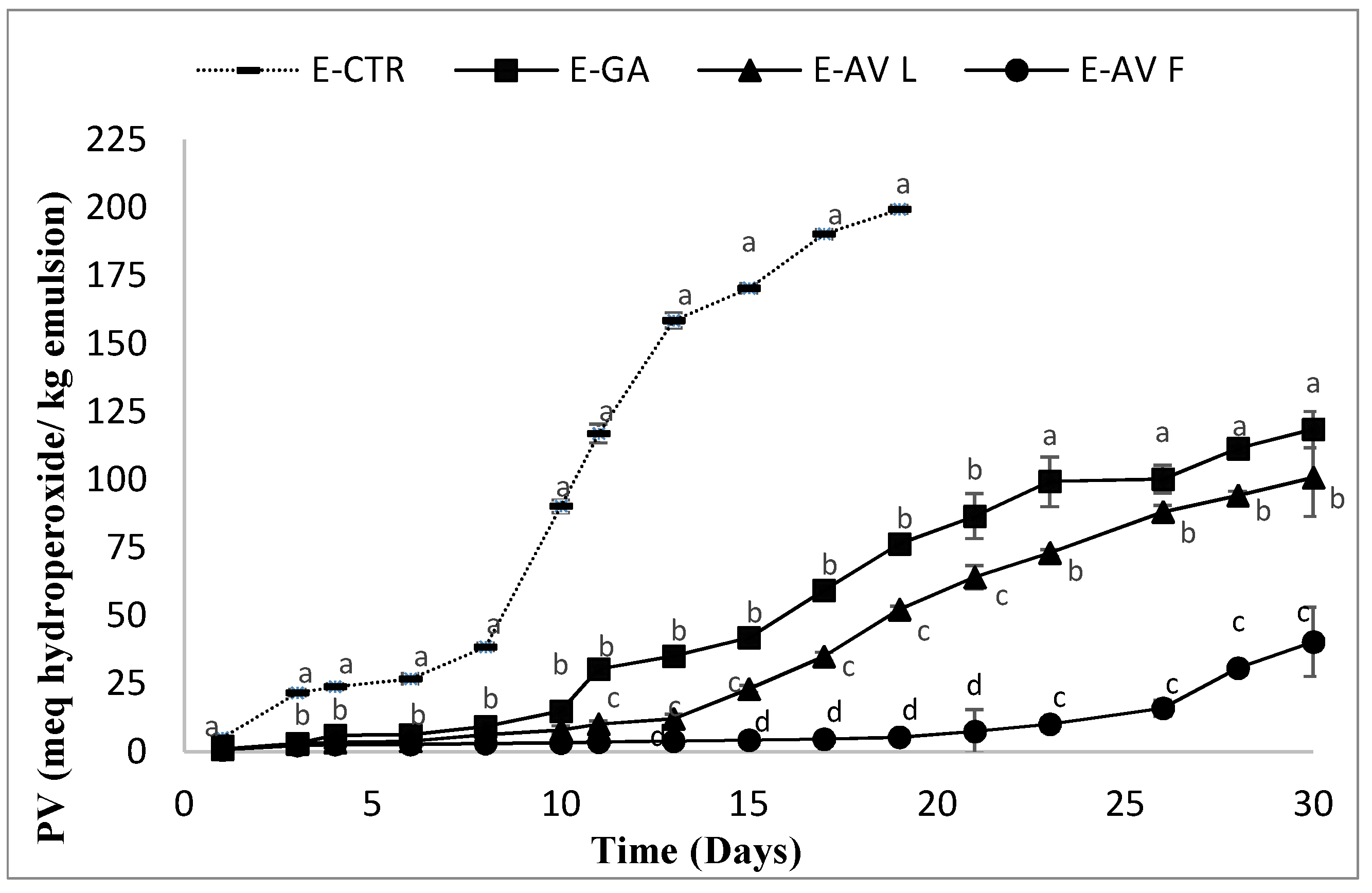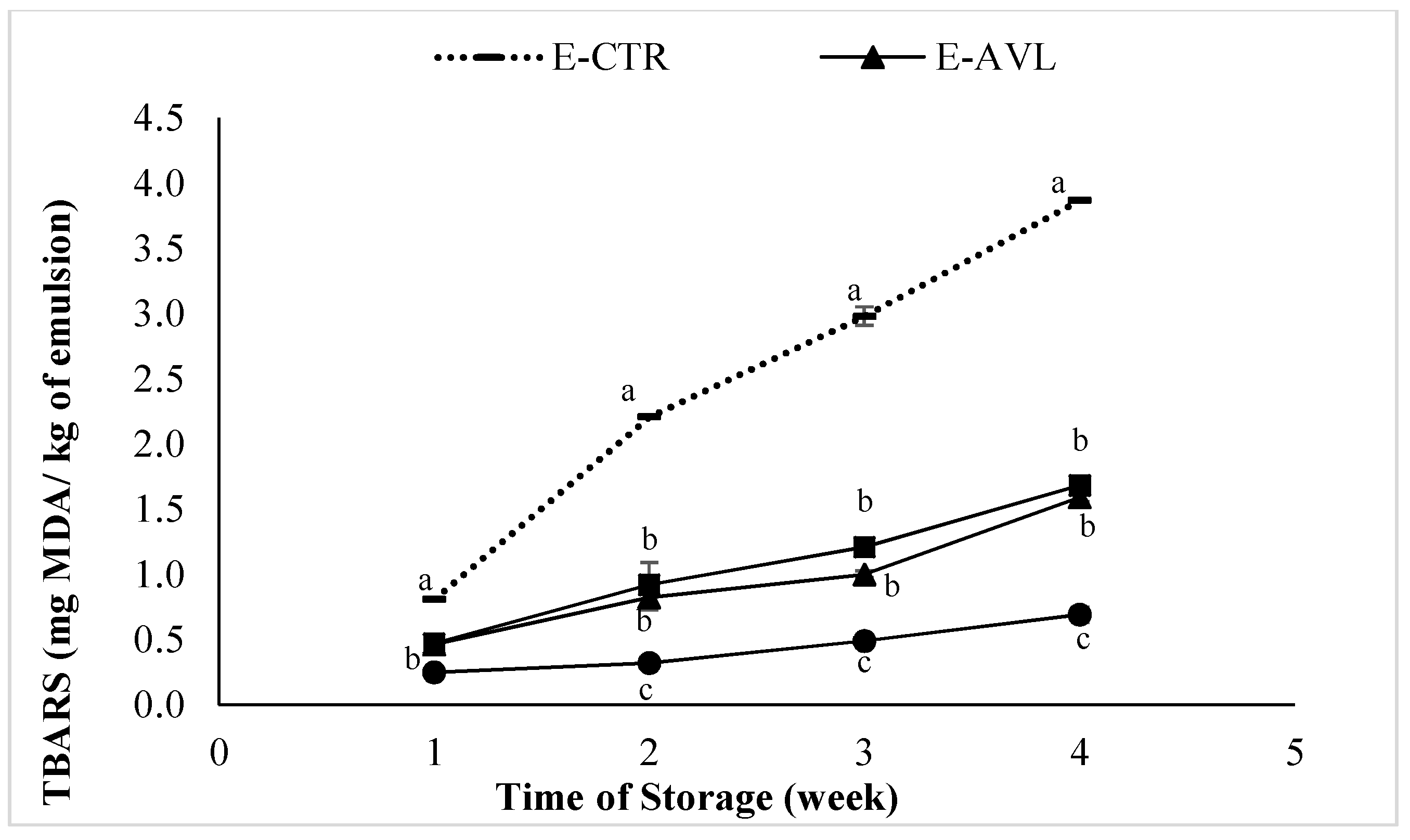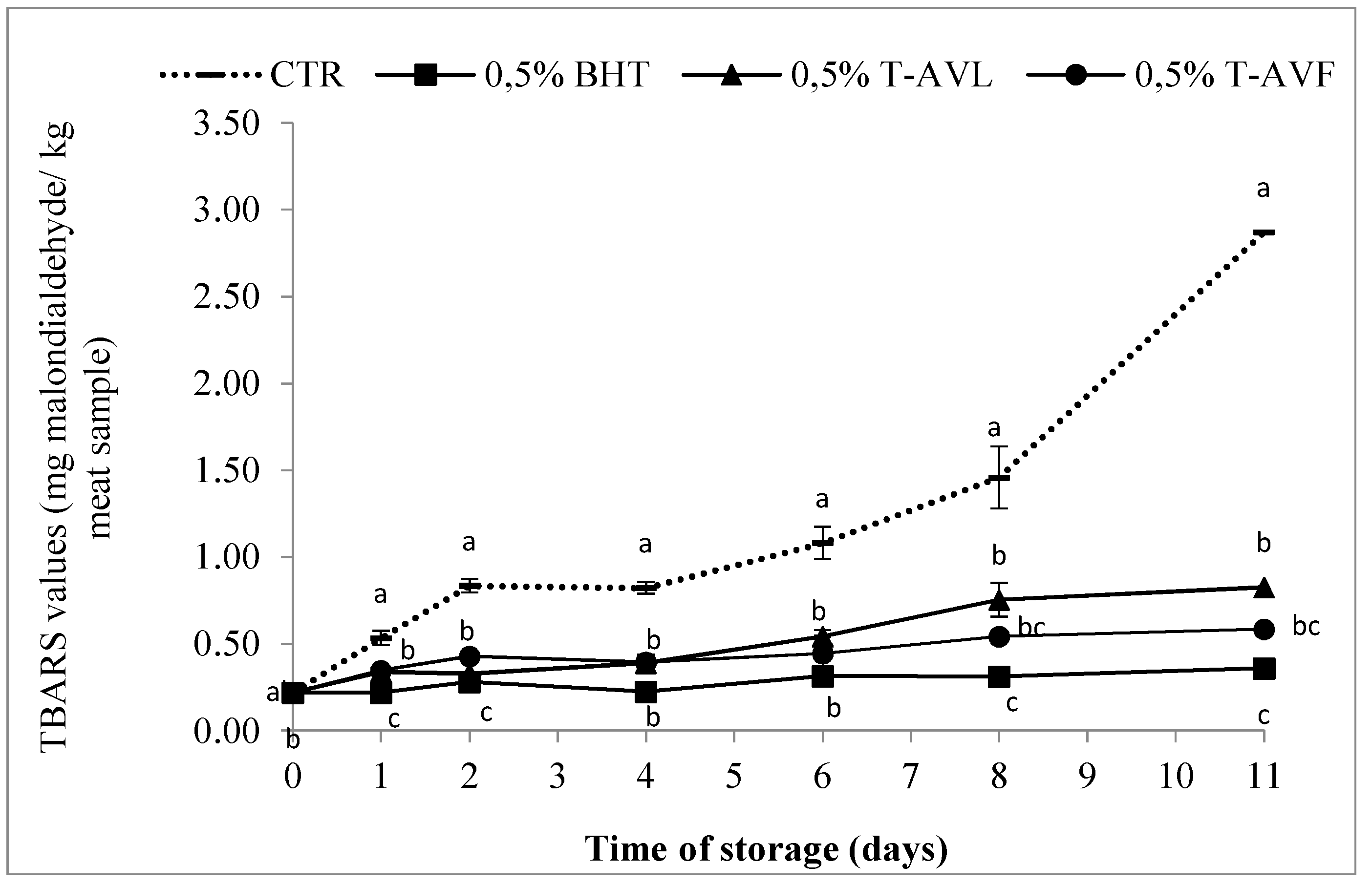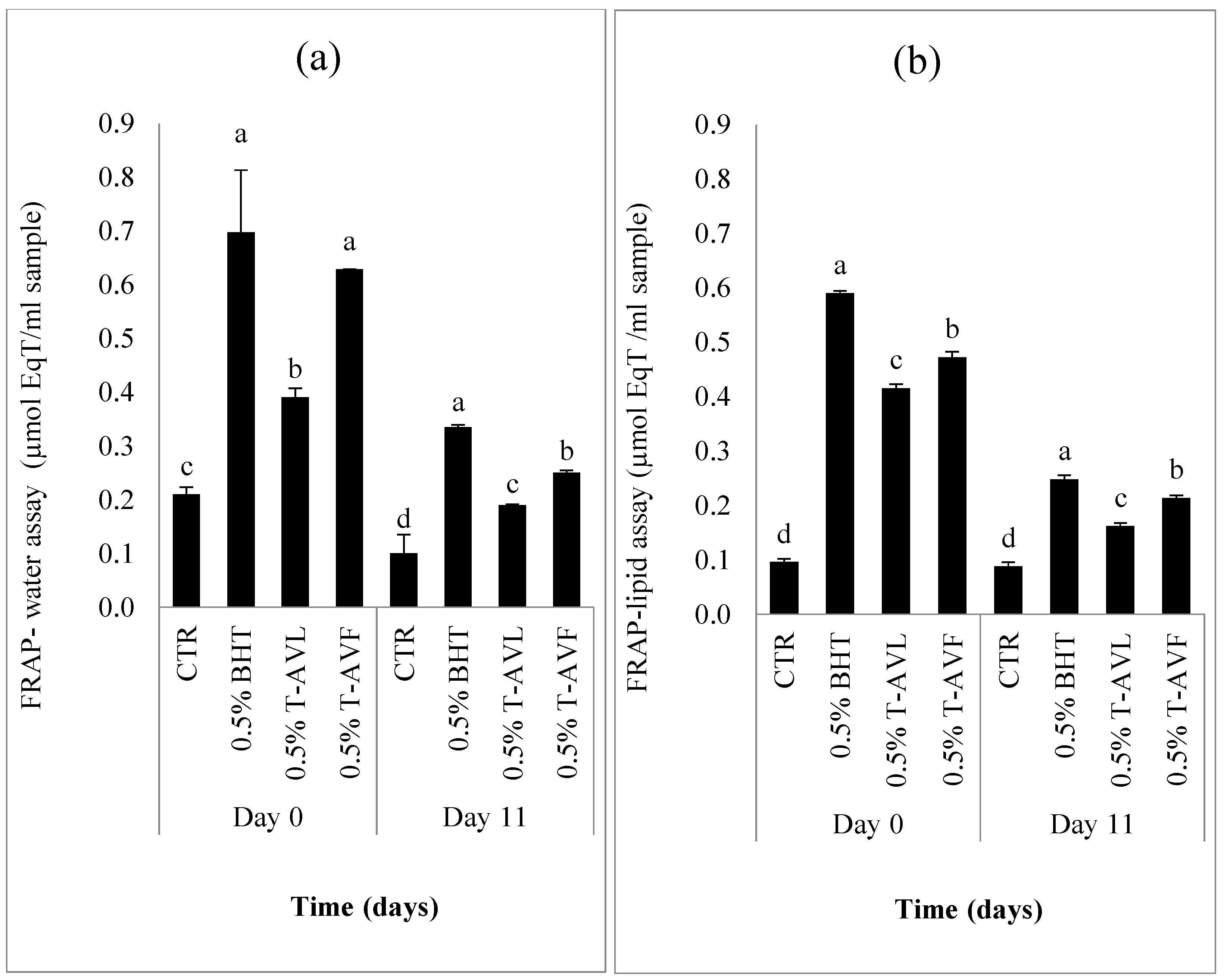Radical Scavenging and Antioxidant Activity of Anthyllis Vulneraria Leaves and Flowers
Abstract
:1. Introduction
2. Results and Discussion
2.1. Total Polyphenol and Flavonoidcontents
2.2. Antioxidant Activity
2.2.1. Free Radical Scavenging Activity
2.2.2. Effects of the A. vulneraria Extracts on the Oxidative Stability of Emulsions
2.2.3. Effects of Powdered A. vulneraria on Raw Meat Oxidative Stability
Lipid Oxidation and Changes in pH Values
Color Changes
Antioxidant Capacity Determined by the FRAP Assay
Sensory Characteristics
3. Materials and Methods
3.1. Reagents and Chemicals
3.2. Spectrophotometric Measurements
3.3. Determination of Phenolic Compounds and Free Radical Scavenging Capacity
3.3.1. A. vulneraria Samples and Extraction Procedure
3.3.2. Total Polyphenol Content (TPC)
3.3.3. Total Flavonoid Content (TFC)
3.3.4. Ferric Reducing Antioxidant Power (FRAP) Assay
3.3.5. Oxygen Radical Absorbance Capacity (ORAC) Assay
3.3.6. Trolox Equivalent Antioxidant Capacity (TEAC) Assay
3.3.7. Diphenyl Picrylhydrazyl (DPPH) Assay
3.4. Evaluation of the Antioxidant Effect of the A. vulneraria Extracts in an Oil-in-Water Emulsion System
3.4.1. Preparation of Emulsion
3.4.2. Conditioning of the A. vulneraria Extracts in Emulsions
3.4.3. Peroxide Value (PV) and pH Measurement
3.4.4. Thiobarbituric Acid Reactive Substances (TBARS) Assay
3.5. Evaluation of the Antioxidant Effect of the Powdered A. vulneraria on Raw Ground Meat Quality
3.5.1. Treatment, Preparation and Storage Conditions of the Raw Beef Patties
3.5.2. Thiobarbituric Acid Reactive Substance Values (TBARS) and pH Measurement
3.5.3. Color Stability Evaluation
3.5.4. Antioxidant Capacity Measurement (AOC)
3.5.5. Sensory Analysis
4. Conclusions
Author Contributions
Funding
Acknowledgments
Conflicts of Interest
References
- Ouerghemmi, I.; Bettaieb Rebey, I.; Rahali, F.Z.; Bourgou, S.; Pistelli, L.; Ksouri, R.; Marzouk, B.; Saidani Tounsi, M. Antioxidant and antimicrobial phenolic compounds from extracts of cultivated and wild-grown Tunisian Ruta chalepensis. J. Food Drug Anal. 2017, 25, 350–359. [Google Scholar] [CrossRef] [PubMed]
- Gallego, M.G.; Rodriguez, T.; Rodriguez, I.; Almajano, M.P. Analytical Characterization of Polyphenols from Tara and Caesalpinia decapetala as Stabilizers of O/W Emulsions. J. Food Sci. 2016, 81, C2676–C2685. [Google Scholar] [CrossRef] [PubMed]
- Kchaou, W.; Abbès, F.; Mansour, R.B.; Blecker, C.; Attia, H.; Besbes, S. Phenolic profile, antibacterial and cytotoxic properties of second grade date extract from Tunisian cultivars (Phoenix dactylifera L.). Food Chem. 2016, 194, 1048–1055. [Google Scholar] [CrossRef] [PubMed]
- Zilani, M.N.H.; Sultana, T.; Asabur Rahman, S.M.; Anisuzzman, M.; Islam, M.A.; Shilpi, J.A.; Hossain, M.G. Chemical composition and pharmacological activities of Pisum sativum. BMC Complement. Altern. Med. 2017, 17, 1–9. [Google Scholar] [CrossRef] [PubMed]
- Maqsood, S.; Benjakul, S. Comparative studies of four different phenolic compounds on in vitro antioxidative activity and the preventive effect on lipid oxidation of fish oil emulsion and fish mince. Food Chem. 2010, 119, 123–132. [Google Scholar] [CrossRef]
- Pisoschi, A.M.; Pop, A. The role of antioxidants in the chemistry of oxidative stress: A review. Eur. J. Med. Chem. 2015, 97, 55–74. [Google Scholar] [CrossRef] [PubMed]
- Gallego, G.; Hakkarainen, M.; Almajano, M.P. Stability of O/W emulsions packed with PLA film with incorporated rosemary and thyme. Eur. Food Res. Technol. 2016, 1–11. [Google Scholar] [CrossRef]
- Lin, M.-J.; Chang, S.-C.; Jea, Y.-S.; Liao, J.-W.; Fan, Y.-K.; Lee, T.-T. In vitro antioxidant capability and performance assessment of White Roman goose supplemented with dried Toona sinensis. J. Appl. Anim. Res. 2016, 44, 395–402. [Google Scholar] [CrossRef]
- Wardhani, D.H.; Fuciños, P.; Vázquez, J.A.; Pandiella, S.S. Inhibition kinetics of lipid oxidation of model foods by using antioxidant extract of fermented soybeans. Food Chem. 2013, 139, 837–844. [Google Scholar] [CrossRef] [PubMed]
- Balasundram, N.; Sundram, K.; Samman, S. Phenolic compounds in plants and agri-industrial by-products: Antioxidant activity, occurrence, and potential uses. Food Chem. 2006, 99, 191–203. [Google Scholar] [CrossRef]
- Wang, Y.C.; Chuang, Y.C.; Ku, Y.H. Quantitation of bioactive compounds in citrus fruits cultivated in Taiwan. Food Chem. 2007, 102, 1163–1171. [Google Scholar] [CrossRef]
- Palici, I.F.; Liktor-Busa, E.; Zupkó, I.; Touzard, B.; Chaieb, M.; Urbán, E.; Hohmann, J. Study of in vitro antimicrobial and antiproliferative activities of selected Saharan plants. Acta Biol. Hung. 2015, 66, 385–394. [Google Scholar] [CrossRef] [PubMed]
- Mhalla, D.; Bouaziz, A.; Ennouri, K.; Chawech, R.; Smaoui, S.; Jarraya, R.; Tounsi, S.; Trigui, M. Antimicrobial activity and bioguided fractionation of Rumex tingitanus extracts for meat preservation. Meat Sci. 2017, 125, 22–29. [Google Scholar] [CrossRef] [PubMed]
- Gepts, P.; Beavis, W.D.; Brummer, E.C.; Shoemaker, R.C.; Stalker, H.T.; Weeden, N.F.; Young, N.D. Legumes as a model plant family. Genomics for food and feed report of the Cross-Legume Advances Through Genomics Conference. Plant Physiol. 2005, 137, 1228–1235. [Google Scholar] [CrossRef] [PubMed]
- Graham, P.H.; Vance, C.P. Update on Legume Utilization Legumes: Importance and Constraints to Greater Use. Plant Physiol. 2014, 131, 872–877. [Google Scholar] [CrossRef] [PubMed]
- Nartowska, J.; Wawer, I.; Strzelecka, H. Triterpenoid sapogenin from Anthyllis vulneraria L. Acta Pol. Pharm. Drug Res. 2001, 58, 289–291. [Google Scholar]
- Halabalaki, M.; Urbain, A.; Paschali, A.; Mitakou, S.; Tillequin, F.; Skaltsounis, A.L. Quercetin and kaempferol 3-O-[α-l-rhamnopyranosyl-(→2)-α-l-arabinopyranoside]-7-O-α-l-rhamnopyranosides from Anthyllis hermanniae: Structure determination and conformational studies. J. Nat. Prod. 2011, 74, 1939–1945. [Google Scholar] [CrossRef] [PubMed]
- Suganda, A.G.; Amoros, M.; Girre, L.; Fauconnier, B. Purifies De Plantes Indigenes Francaises Sur La Multiplication De L ’ Herpesvirus Humain 1 Et Du. J. Nat. Prod. 1983, 4, 626–632. [Google Scholar] [CrossRef]
- Godevac, D.; Zdunić, G.; Šavikin, K.; Vajs, V.; Menković, N. Antioxidant activity of nine Fabaceae species growing in Serbia and Montenegro. Fitoterapia 2008, 79, 185–187. [Google Scholar] [CrossRef] [PubMed]
- Csepregi, R.; Bencsik, T.; Papp, N. Examination of secondary metabolites and antioxidant capacity of Anthyllis vulneraria, Fuchsia sp., Galium mollugo and Veronica beccabunga. Acta Biol. Hung. 2016, 67, 442–446. [Google Scholar] [CrossRef] [PubMed]
- Tusevski, O.; Kostovska, A.; Iloska, A.; Trajkovska, L.; Simic, S.G. Phenolic production and antioxidant properties of some Macedonian medicinal plants. Cent. Eur. J. Biol. 2014, 9, 888–900. [Google Scholar] [CrossRef]
- Son, S.Y.; Kim, N.K.; Lee, S.; Singh, D.; Kim, G.R.; Lee, J.S.; Yang, H.S.; Yeo, J.; Lee, S.; Lee, C.H. Metabolite fingerprinting, pathway analyses, and bioactivity correlations for plant species belonging to the Cornaceae, Fabaceae, and Rosaceae families. Plant Cell Rep. 2016, 35, 1917–1931. [Google Scholar] [CrossRef] [PubMed]
- Skowyra, M.; Gallego, G. Antioxidant properties of aqueous and ethanolic extracts of tara (Caesalpinia spinosa) pods in vitro and in model food emulsions. J. Sci Food Agric. 2013, 94, 911–918. [Google Scholar] [CrossRef] [PubMed]
- Ksouri, R.; Megdiche, W.; Falleh, H.; Trabelsi, N.; Boulaaba, M.; Smaoui, A.; Abdelly, C. Influence of biological, environmental and technical factors on phenolic content and antioxidant activities of Tunisian halophytes. Comptes Rendus Biologies 2008, 331, 865–873. [Google Scholar] [CrossRef] [PubMed]
- Santas, J.; Carbó, R.; Gordon, M.H.; Almajano, M.P. Comparison of the antioxidant activity of two Spanish onion varieties. Food Chem. 2008, 107, 1210–1216. [Google Scholar] [CrossRef]
- Gallego, M.G.; Gordon, M.H.; Segovia, F.J.; Skowyra, M.; Almajano, M.P. Antioxidant properties of three aromatic herbs (rosemary, thyme and lavender) in oil-in-water emulsions. J. Am. Oil Chem. Soc. 2013, 90, 1559–1568. [Google Scholar] [CrossRef]
- Pahua-Ramos, M.E.; Ortiz-Moreno, A.; Chamorro-Cevallos, G.; Hernández-Navarro, M.D.; Garduño-Siciliano, L.; Necoechea-Mondragón, H.; Hernández-Ortega, M. Hypolipidemic Effect of Avocado (Persea americana Mill) Seed in a Hypercholesterolemic Mouse Model. Plant Foods Hum. Nutr. 2012, 67, 10–16. [Google Scholar] [CrossRef] [PubMed]
- Cheung, L.M.; Cheung, P.C.K.; Ooi, V.E.C. Antioxidant activity and total phenolics of edible mushroom extracts. Food Chem. 2003, 81, 249–255. [Google Scholar] [CrossRef]
- Ye, F.; Liang, Q.; Li, H.; Zhao, G. Solvent effects on phenolic content, composition, and antioxidant activity of extracts from florets of sunflower (Helianthus annuus L.). Ind. Crops Prod. 2015, 76, 574–581. [Google Scholar] [CrossRef]
- Saha, J.; Debnath, M.; Saha, A.; Ghosh, T.; Sarkar, P.K. Response surface optimisation of extraction of antioxidants from strawberry fruit, and lipid peroxidation inhibitory potential of the fruit extract in cooked chicken patties. J. Sci. Food Agric. 2011, 91, 1759–1765. [Google Scholar] [CrossRef] [PubMed]
- Fernández-Agulló, A.; Pereira, E.; Freire, M.S.; Valentão, P.; Andrade, P.B.; González-álvarez, J.; Pereira, J.A. Influence of solvent on the antioxidant and antimicrobial properties of walnut (Juglans regia L.) green husk extracts. Ind. Crops Prod. 2013, 42, 126–132. [Google Scholar] [CrossRef]
- Veloz-García, R.A.; Marín-Martínez, R.; Veloz-Rodríguez, R.; Muñoz-Sánchez, C.I.; Guevara-Olvera, L.; Miranda-López, R.; González-Chavira, M.M.; Torres-Pacheco, I.; Guzmán-Maldonado, S.H.; Cardador-Martínez, A.; et al. Antimutagenic and antioxidant activities of cascalote (Caesalpinia cacalaco) phenolics. J. Sci. Food Agric. 2004, 84, 1632–1638. [Google Scholar] [CrossRef]
- Feregrino-Pérez, A.A.; Torres-Pacheco, I.; Vargas-Hernández, M.; Munguía-Fragozo, P.V.; Loarca-Piña, G.F.; Mendoza-Díaz, S.O.; Ocampo-Velázquez, R.V.; Rico-García, E.; Guevara-Gónzalez, R.G. Antioxidant and antimutagenic activities of Acacia pennatula pods. J. Sci. Ind. Res. 2011, 70, 859–864. [Google Scholar]
- Karakoca, K.; Asan-Ozusaglam, M.; Cakmak, Y.S.; Teksen, M. Phenolic Compounds, biological and antioxidant activities of onobrychis armena Boiss. & Huet flower and root extracts. Chiang Mai J. Sci. 2015, 42, 376–392. [Google Scholar]
- Kenny, O.; Smyth, T.J.; Hewage, C.M.; Brunton, N.P. Antioxidant properties and quantitative UPLC-MS analysis of phenolic compounds from extracts of fenugreek (Trigonella foenum-graecum) seeds and bitter melon (Momordica charantia) fruit. Food Chem. 2013, 141, 4295–4302. [Google Scholar] [CrossRef] [PubMed]
- Skowyra, M.; Gallego, M.; Segovia, F.; Almajano, M. Antioxidant Properties of Artemisia annua Extracts in Model Food Emulsions. Antioxidants 2014, 3, 116–128. [Google Scholar] [CrossRef] [PubMed] [Green Version]
- Azman, N.; Segovia, F.; Martínez-Farré, X.; Gil, E.; Almajano, M. Screening of Antioxidant Activity of Gentian Lutea Root and Its Application in Oil-in-Water Emulsions. Antioxidants 2014, 3, 455–471. [Google Scholar] [CrossRef] [PubMed]
- Segovia Gómez, F.; Almajano Pablos, M.P. Pineapple Waste Extract for Preventing Oxidation in Model Food Systems. J. Food Sci. 2016, 81, C1622–C1628. [Google Scholar] [CrossRef] [PubMed]
- Davey, M.W.; Stals, E.; Panis, B.; Keulemans, J.; Swennen, R.L. High-throughput determination of malondialdehyde in plant tissues. Anal. Biochem. 2005, 347, 201–207. [Google Scholar] [CrossRef] [PubMed]
- Frankel, E.N.; Huang, S.W.; Aeschbach, R.; Prior, E. Antioxidant Activity of a Rosemary Extract and Its Constituents, Carnosic Acid, Carnosol, and Rosmarinic Acid, in Bulk Oil and Oil-in-Water Emulsion. J. Agric. Food Chem. 1996, 44, 131–135. [Google Scholar] [CrossRef]
- Decker, E.A.; Warner, K.; Richards, M.P.; Shahidi, F. Measuring antioxidant effectiveness in food. J. Agric. Food Chem. 2005, 53, 4303–4310. [Google Scholar] [CrossRef] [PubMed]
- Sun, Y.E.; Wang, W.D.; Chen, H.W.; Li, C. Autoxidation of unsaturated lipids in food emulsion. Crit. Rev. Food Sci. Nutr. 2011, 51, 453–466. [Google Scholar] [CrossRef] [PubMed]
- Leygonie, C.; Britz, T.J.; Hoffman, L.C. Impact of freezing and thawing on the quality of meat: Review. Meat Sci. 2012, 91, 93–98. [Google Scholar] [CrossRef] [PubMed]
- Riazi, F.; Zeynali, F.; Hoseini, E.; Behmadi, H.; Savadkoohi, S. Oxidation phenomena and color properties of grape pomace on nitrite-reduced meat emulsion systems. Meat Sci. 2016, 121, 350–358. [Google Scholar] [CrossRef] [PubMed]
- .Skowyra, M.; Janiewicz, U.; Salejda, A.M.; Krasnowska, G.; Almajano, M.P. Effect of tara (Caesalpinia spinosa) pod powder on the oxidation and colour stability of pork meat batter during chilled storage. Food Technol. Biotechnol. 2015, 53, 419–427. [Google Scholar] [CrossRef] [PubMed]
- Azman, A.; Gallego, M.; Julià, L.; Fajari, L.; Almajano, M.P. The effect of convolvulus arvensis dried extract as a potential antioxidant in food models. Antioxidants 2015, 4, 170–184. [Google Scholar] [CrossRef] [PubMed] [Green Version]
- Muela, E.; Sañudo, C.; Campo, M.M.; Medel, I.; Beltrán, J.A. Effect of freezing method and frozen storage duration on instrumental quality of lamb throughout display. Meat Sci. 2010, 84, 662–669. [Google Scholar] [CrossRef] [PubMed]
- Li, M.; Li, X.; Xin, J.; Li, Z.; Li, G.; Zhang, Y.; Du, M.; Shen, Q.W.; Zhang, D. Effects of protein phosphorylation on color stability of ground meat. Food Chem. 2017, 219, 304–310. [Google Scholar] [CrossRef] [PubMed]
- Gallego, M.G.; Gordon, M.H.; Segovia, F.J.; Almajano, M.P. Caesalpinia decapetala Extracts as Inhibitors of Lipid Oxidation in Beef Patties. Molecules 2015, 20, 13913–13926. [Google Scholar] [CrossRef] [PubMed] [Green Version]
- Hawashin, M.D.; Al-Juhaimi, F.; Ahmed, I.A.M.; Ghafoor, K.; Babiker, E.E. Physicochemical, microbiological and sensory evaluation of beef patties incorporated with destoned olive cake powder. Meat Sci. 2016, 122, 32–39. [Google Scholar] [CrossRef] [PubMed]
- Mancini, R.A.; Hunt, M.C. Current research in meat color. Meat Sci. 2005, 71, 100–121. [Google Scholar] [CrossRef] [PubMed]
- Muthukumar, M.; Naveena, B.M.; Vaithiyanathan, S.; Sen, A.R.; Sureshkumar, K. Effect of incorporation of Moringa oleifera leaves extract on quality of ground pork patties. J. Food Sci. Technol. 2012, 51, 3172–3180. [Google Scholar] [CrossRef] [PubMed] [Green Version]
- Esmer, O.K.; Irkin, R.; Degirmencioglu, N.; Degirmencioglu, A. The effects of modified atmosphere gas composition on microbiological criteria, color and oxidation values of minced beef meat. Meat Sci. 2011, 88, 221–226. [Google Scholar] [CrossRef] [PubMed]
- Pękal, A.; Pyrzynska, K. Evaluation of Aluminium Complexation Reaction for Flavonoid Content Assay. Food Anal. Methods. 2014, 7, 1776–1782. [Google Scholar] [CrossRef] [Green Version]
- Shalaby, E.A.; Shanab, S.M.M. Comparison of DPPH and ABTS assays for determining antioxidant potential of water and methanol extracts of Spirulina platensis. Indian J. Geomarine Sci. 2013, 42, 556–564. [Google Scholar]
Sample Availability: Samples of the A. vulneraria are available from the authors. |





| Samples | TPC (mg GAE/g Dry Plant) | TFC (mg QE/g Dry Plant) |
|---|---|---|
| Leaf | 82.86 ± 1.22 b | 20.14 ± 0.18 b |
| Flower | 134.31 ± 1.64 a | 33.58 ± 4.07 a |
| Samples | FRAP (mM Trolox/g Dry Plant) | ORAC (mM Trolox/g Dry Plant) | TEAC (mM Trolox/g Dry Plant) | DPPH (mM Trolox/g Dry Plant) |
|---|---|---|---|---|
| Leaves | 1.90 ± 0.01 b | 0.98 ± 0.003 b | 0.82 ± 0.002 b | 0.33 ± 1.08 b |
| Flowers | 3.30 ± 0.01 a | 1.64 ± 0.07 a | 1.42 ± 0.01 a | 0.64 ± 0.96 a |
| Days of Storage | 1 | 2 | 4 | 6 | 8 | 11 |
|---|---|---|---|---|---|---|
| CTR | 5.86 ± 0.03 a | 5.89 ± 0.02 a | 5.92 ± 0.01 a | 5.97 ± 0.02 a | 6.01 ± 0.02 a | 6.19 ± 0.03 a |
| BHT | 5.69 ± 0.01 c | 5.70 ± 0.11 b | 5.72 ± 0.02 c | 5.74 ± 0.01 b | 5.77 ± 0.01 c | 5.78 ± 0.02 c |
| T-AVL | 5.76 ± 0.01 b | 5.78 ± 0.03 ab | 5.82 ± 0.03 b | 5.87 ± 0.1 ab | 5.93 ± 0.1 ab | 6.01 ± 0.05 b |
| T-AVF | 5.71 ± 0.01 c | 5.74 ± 0.02 b | 5.79 ± 0.05 bc | 5.81 ± 0.03 ab | 5.84 ± 0.03 bc | 5.86 ± 0.02 c |
| Trait | Days | CTR | BHT | T-AVL | T-AVF |
|---|---|---|---|---|---|
| Redness (a*) | 1 | 36.67 ± 2.37 a | 52.32 ± 0.98 b | 43.75 ± 4.28 ab | 49.46 ± 0.37 ab |
| 2 | 33.80 ± 0.37 a | 49.26 ± 2.56 b | 39.96 ± 1.23 ab | 48.01 ± 0.05 ab | |
| 4 | 27.95 ± 0.71 a | 48.91 ± 1.63 b | 38.21 ± 0.95 ab | 43.07 ± 0.03 ab | |
| 6 | 27.76 ± 0.84 a | 48.77 ± 0.69 b | 38.02 ± 0.47 ab | 41.80 ± 1.85 ab | |
| 8 | 25.14 ± 0.12 a | 43.68 ± 0.81 b | 34.09 ± 0.83 ab | 31.22 ± 0.18 ab | |
| 11 | 24.89 ± 1.23 a | 37.31 ± 1.09 b | 26.84 ± 1.46 ab | 25.74 ± 1.03 ab | |
| Yellowness (b*) | 1 | 10.30 ± 0.17 a | 15.35 ± 0.02 b | 10.45 ± 1.24 a | 14.34 ± 0.57 b |
| 2 | 10.28 ± 1.92 a | 14.63 ± 1.19 b | 9.93 ± 2.51 a | 13.32 ± 0.11 b | |
| 4 | 9.58 ± 1.93 a | 13.43 ± 0.41 b | 9.88 ± 0.15 a | 13.29 ± 0.04 b | |
| 6 | 9.46 ± 0.55 a | 13.35 ± 0.10 b | 8.78 ± 0.04 a | 12.11 ± 0.24 b | |
| 8 | 5.63 ± 0.07 a | 11.79 ± 1.24 b | 8.10 ± 1.00 a | 10.79 ± 0.53 b | |
| 11 | 5.17 ± 1.03 a | 11.13 ± 0.46 b | 5.52 ± 0.95 a | 9.92 ± 0.14 b | |
| Lightness (L*) | 1 | 56.18 ± 0.14 a | 70.80 ± 2.54 ab | 68.36 ± 2.09 ab | 70.99 ± 2.19 b |
| 2 | 55.42 ± 3.07 a | 61.86 ± 1.62 ab | 65.07 ± 2.12 ab | 65.09 ± 4.12 b | |
| 4 | 55.30 ± 0.25 a | 60.61 ± 0.33 ab | 61.52 ± 1.80 ab | 63.70 ± 3.63 b | |
| 6 | 55.04 ± 1.60 a | 56.78 ± 2.78 ab | 58.64 ± 1.97 ab | 62.18 ± 0.40 b | |
| 8 | 52.59 ± 0.50 a | 56.65 ± 1.80 ab | 55.54 ± 1.72 ab | 59.53 ± 0.23 b | |
| 11 | 43.63 ± 2.98 a | 49.39 ± 0.04 ab | 49.74 ± 0.21 ab | 55.61 ± 4.65 b |
| Meat Samples | Number of Assessors | Number of Smokers/Non-Smokers | Odd Samples Identified | Level of Significance | ||||
|---|---|---|---|---|---|---|---|---|
| Male | Female | Total | Smoker | Non-Smoker | Correct (+) | Incorrect (-) | ||
| T-AVL | 18 | 7 | 25 | 1 | 24 | 23 | 2 | 0.1% |
| T-AVF | 18 | 12 | 30 | 3 | 27 | 23 | 7 | 0.1% |
© 2018 by the authors. Licensee MDPI, Basel, Switzerland. This article is an open access article distributed under the terms and conditions of the Creative Commons Attribution (CC BY) license (http://creativecommons.org/licenses/by/4.0/).
Share and Cite
Ouerfelli, M.; Bettaieb Ben Kâab, L.; Almajano, M.P. Radical Scavenging and Antioxidant Activity of Anthyllis Vulneraria Leaves and Flowers. Molecules 2018, 23, 1657. https://doi.org/10.3390/molecules23071657
Ouerfelli M, Bettaieb Ben Kâab L, Almajano MP. Radical Scavenging and Antioxidant Activity of Anthyllis Vulneraria Leaves and Flowers. Molecules. 2018; 23(7):1657. https://doi.org/10.3390/molecules23071657
Chicago/Turabian StyleOuerfelli, Manel, Leila Bettaieb Ben Kâab, and María Pilar Almajano. 2018. "Radical Scavenging and Antioxidant Activity of Anthyllis Vulneraria Leaves and Flowers" Molecules 23, no. 7: 1657. https://doi.org/10.3390/molecules23071657







